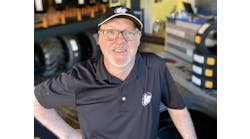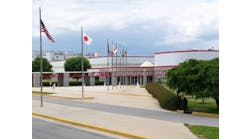Twelve years ago, when Michael and Jessica Spencer opened TireSouth Inc. in the midst of the Great Recession, plenty of people warned them they were crazy.
“Now is not the time to open a business,” Jessica remembers the chorus telling them.
And it wasn’t easy. But that first TireSouth store in McDonough, Ga. is thriving and the Spencers are preparing to open their sixth store in the Atlanta, Ga., market during the second quarter of 2022.
Jessica, a second-generation tire dealer, hadn’t really considered following her parents into the tire business until the recession hit.
“That’s when the tire business really shined,” she says. “All my friends and people I knew in construction and other businesses like that” were out of work.
“In tires, it wasn’t our busiest time, but we were still carrying on. It became more attractive and it just hit me. All the training my Dad had given me and all the things I had watched as a kid — it all fell into place. The lightbulb went off.”
Jessica had grown up in her family’s business, Larry’s New & Used Tires Inc. She worked there after school and on weekends.
Michael had also grown up in a small family business. They say opening their own tire dealership felt like the right path.
But they were adamant they wanted to forge their own way. “We started this when we were both 24,” he says. “We’ve learned every lesson along the way — made every mistake you could. Now, we’ve kind of figured out what we’re about, what our niche is and what works for us. We have a pretty good formula that’s ready to scale.”
That niche might sound like a cliche, but it’s proven to be successful.
“We’re service-oriented,” says Michael. “We’re customer-centric.”
And with that mission, TireSouth has grown.
The dealership’s first few additional stores weren’t locations the Spencers had scouted and dreamed of opening. They were necessities to expand capacity and serve more customers.
“We had too many customers and couldn’t handle them all at the original location, so it required us to open another,” says Michael. “That’s how we want to focus our growth — not just in store count, not just by opening in different markets. We grow because our customers demand it of us. We’ve put customer centricity at the forefront and it’s really worked out well.”
They’ve since taken over the two stores Jessica’s parents owned in Clayton County, Ga., south of Atlanta.
Now with five stores around the Atlanta metro area, TireSouth has grown to have 30 service bays and annual sales of $15 million. Tire sales and automotive service are a 50-50 mix. The company has 50 employees.
Growth in UHP
One piece of TireSouth’s success comes from sales of ultra-high performance (UHP) tires. Michael says the process begins with “asking a lot of questions.
“A lot of new vehicles are coming with UHP tires versus standard touring or all-season tires. When it comes to replacement, a lot of times the consumer doesn’t know that.
“So we’re asking about their driving characteristics and (are) asking, ‘What did you like about your vehicle when you bought it new?’
“We’re trying to get to the root of what they’re going to be happy with versus just matching the fitment.”
That same practice applies to the growing number of customers who are interested in off-roading.
“‘What are you trying to achieve? Are you going for a look or do you want something that’s off-road-capable?’ I think the more questions our salespeople ask, the better our shop is able to achieve the results a customer is after.”
The CUV, SUV and light truck markets are all increasing pieces of the UHP tire pie.
“We’ve always done a lot of pickup trucks and light trucks because that’s what’s on the road around here.
“Looking at the CUV/SUV market when it comes to UHP and performance, that is a segment that over the last couple of years has grown a lot for us.”
Michael says UHP tires from Hankook Tire North America have been especially popular with TireSouth’s customers.
“Hankook has been a big one for us as of late. They have a good value proposition when weighing performance and price.”
Jessica notes that warranties also have developed into “a good selling point.”
And while they say tire supply has been tight across the board, Michael admits the issue has been “maybe a little worse” for UHP tires than other products TireSouth sells.
In general, he thinks any kind of specialty tire has been “a little bit tougher to track down” than an entry-level product or passenger touring tire.
One thing that hasn’t affected UHP tire sales is consumer spending habits.
The Spencers say their customers have accepted the price increases that have come down the pike over the last year.
Jessica says that “2021 was a big spending year for our customers. I don’t feel like we had a lot of pushback on price, which is odd for a pandemic and all the uncertainty. Hopefully, it stays that way.”
Michael attributes some of the dealership’s ability to overcome increased pricing to the work and time TireSouth employees spend educating consumers.
They’re “explaining the value proposition or the characteristics that come along with a UHP tire versus an entry-level touring tire.
“I think it comes down to educating the customer, then stepping back and letting them make the decision. We try to explain the value and what we’re offering.
“If you take the time to explain it, most of them are going to end up in the tire that’s better-suited for them and their vehicle.”
Supply chain lessons
The struggle to find tires is accelerating TireSouth’s plans to someday stock and manage its own warehouse. For now, the company’s five stores mostly rely on daily deliveries from tire distributors.
A distribution center is likely in the cards at some point as the company adds more stores. The Spencers agree that issues over the past year have emphasized this need.
“Being more vertically integrated on our supply line is something that is very, very attractive to us,” says Michael.
“To be able to control that supply and not be so reliant on distributors” is appealing. And supply chain issues have “probably expedited our plans on that.
“As we grow, we would like to buy more direct,” says Jessica. “We just haven’t shifted over yet.”
Unlike their counterparts in other areas of the country, TireSouth and other tire dealers in Atlanta aren’t that far from a good number of the nation’s tire manufacturing plants.
Has that lessened the blow of tire supply issues? “I would assume” that availability is better, says Jessica. “It’s been a challenge, but it hasn’t been a total upheaval in our business.
“Sometimes you just have to work on tracking something down a little bit harder. But there are very few instances where we just can’t find something or you have a back-order status that doesn’t have an end date to it. (Tires) have been tougher to find, but we’ve been able to get our hands on them 99% of the time.”
Caring for employees
As the Spencers work around supply challenges, they are applying the lessons they’ve learned from serving customers to managing their team.
“It’s the old saying ‘Take care of the customer and they’ll take care of you,’” says Jessica. “It’s held true — and with employees, too.
“We’re in a time where staffing shortages are everywhere. If you take care of your people — customers and employees — you’ll find a way to make it through and thrive.”
In employee relations, that mindset is important. Jessica says she thinks there’s an advantage to being “not too big and not too small.”
TireSouth has “always treated (our people) well (and) gone above and beyond. I think we treat and pay people a lot better than our competitors do and I think they know that.”
The Spencers aren’t shy about sharing their vision and mission with employees, says Michael.
“We want them to be part of the growth and let them know where our heads are at and where we’re trying to take the company and how that impacts them.
“When they feel they’re a part of something bigger than just their day-to-day jobs, it definitely keeps people more engaged.”
Jessica says she reminds the TireSouth team that “the road to the top of the corporate ladder isn’t that long. We’re not a huge company yet, so if you want to run a store, the climb is not that far. You can do it.
“They see us remodeling stores and building new stores. They see it and believe it and feel that they’re part of it. That keeps them motivated and that pushes Michael and I to keep healthy growth going, as well.”




